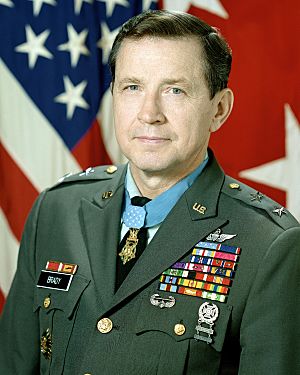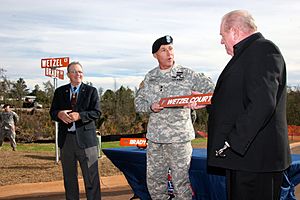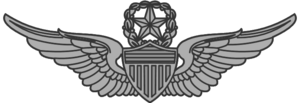Patrick Henry Brady facts for kids
Quick facts for kids
Patrick Henry Brady
|
|
|---|---|

Brady in 1989
|
|
| Born | October 1, 1936 Philip, South Dakota, U.S. |
| Allegiance | United States |
| Service/ |
United States Army |
| Years of service | 1959–1993 |
| Rank | Major General |
| Unit | 54th Medical Detachment |
| Commands held | Detachment "A," 57th Medical Detachment 326th Medical Battalion |
| Battles/wars | Vietnam War |
| Awards |
|
| Spouse(s) | Nancy Brady |

Patrick Henry Brady (born October 1, 1936) is a retired United States Army major general. He is famous for being a helicopter pilot during the Vietnam War. He received the Medal of Honor, which is the highest military award for bravery in the United States.
Contents
Early Life and Education
Patrick Brady grew up in Seattle, Washington. He went to O'Dea High School, an all-boys school. There, he was very active in sports.
Later, he attended Seattle University. At first, he didn't like the required Reserve Officers' Training Corps (ROTC) program. He even got kicked out of it! But he soon realized he would likely be drafted into the military after college. So, he rejoined ROTC to become an officer when he joined the Army.
Military Career Highlights
After graduating from college, Patrick Brady became a second lieutenant in the Army in 1959. He first served in West Berlin from 1959 to 1961. He worked in a hospital and later led a small military unit.
In 1963, he finished flight school at Fort Rucker, Alabama. He became a helicopter pilot. Soon after, in January 1964, he went to Vietnam.
Flying "Dust Off" Missions
During his first time in Vietnam (1964-1965), Captain Brady flew "Dust Off" missions. These missions involved flying helicopters to rescue wounded soldiers. He was part of the 57th Medical Detachment. His commander, Major Charles L. Kelly, was a very brave pilot.
After Major Kelly was killed in action, Captain Brady took over his unit. A commander asked if they would stop flying so dangerously. Brady picked up the bullet that killed Kelly and said they would keep flying just as bravely. He wanted to rescue soldiers without hesitation, anytime, anywhere.
Medal of Honor Actions
Brady returned to Vietnam for a second time from 1967 to 1968. By then, he was a major. He was second in command of the 54th Medical Detachment. It was during this tour that he earned the Medal of Honor.
Major Brady flew over 2,000 combat missions in Vietnam. He helped rescue more than 5,000 wounded people. Many of these rescues happened under heavy enemy fire.
He retired from the United States Army in 1993. He had served for 34 years and reached the rank of major general.
Awards and Recognition
Patrick Brady received many awards for his bravery and service. His most important award is the Medal of Honor.
- Medal of Honor: The highest award for military valor.
- Distinguished Service Cross: The second-highest award for bravery.
- Army Distinguished Service Medal: Awarded for exceptionally outstanding service.
- Distinguished Flying Cross: Awarded for heroism or extraordinary achievement while flying.
- Bronze Star Medal: Awarded for heroic or meritorious achievement or service in a combat zone.
- Air Medal: Awarded for meritorious achievement while participating in aerial flight.
- Purple Heart: Awarded to those wounded or killed in action.
Medal of Honor Story
Major Brady received the Medal of Honor for his actions on January 6, 1968, near Chu Lai, Vietnam. The weather was bad with thick fog, and enemy forces were nearby.
He volunteered to rescue wounded soldiers from a dangerous area. He flew his helicopter through fog and smoke, using the helicopter's blades to clear the way. Even with enemy fire, he landed and rescued two wounded soldiers.
Later that day, he went to another foggy area where American soldiers were hurt very close to the enemy. Two other helicopters had already been shot down trying to reach them. Major Brady made four brave flights to this dangerous spot, rescuing all the wounded.
On his third mission, his helicopter was badly damaged by enemy fire. But he returned minutes later to rescue more injured soldiers. He then got a new helicopter and flew into an enemy minefield where American soldiers were trapped. A mine exploded near his helicopter, hurting two of his crew members and damaging his aircraft. Despite this, he flew six severely injured patients to safety.
Throughout that single day, Major Brady used three different helicopters. He evacuated a total of 51 seriously wounded men. Many of them would not have survived without his quick and brave actions. His bravery showed the highest traditions of military service.
Personal Honors
- He was inducted into the National Aviation Hall of Fame in 2013.
- He is recognized by the Dustoff Association Hall of Fame. "Dustoff" is the nickname for helicopter ambulance units.
See also
Images for kids



